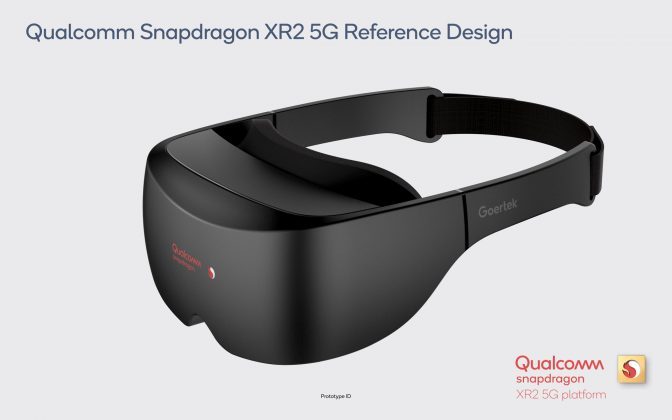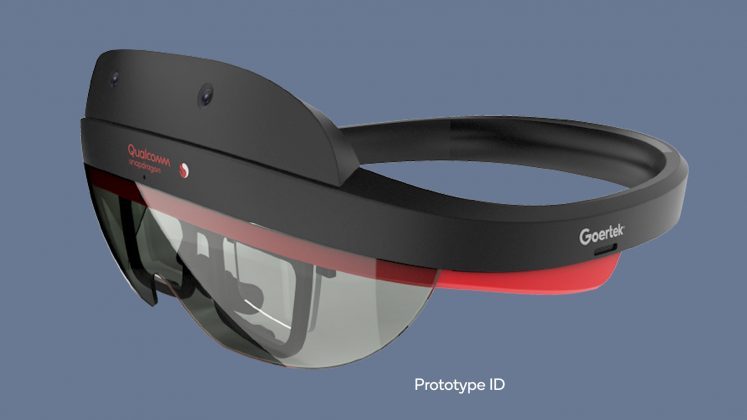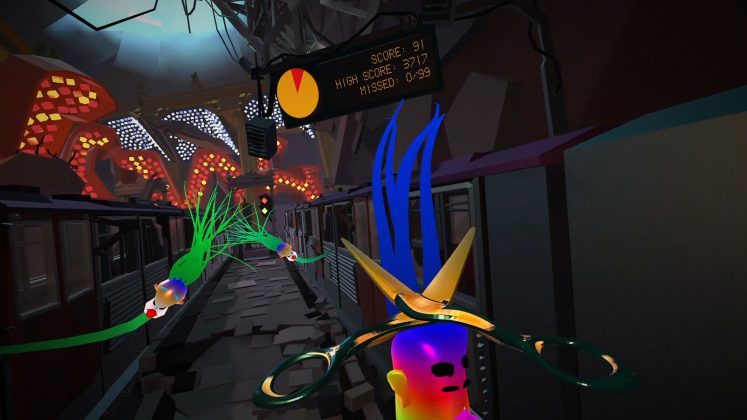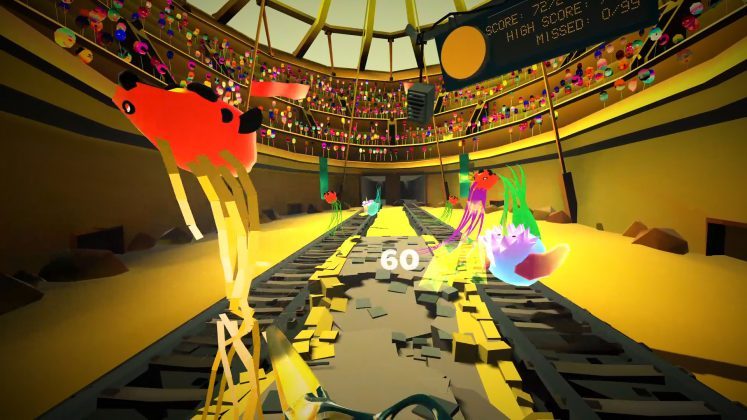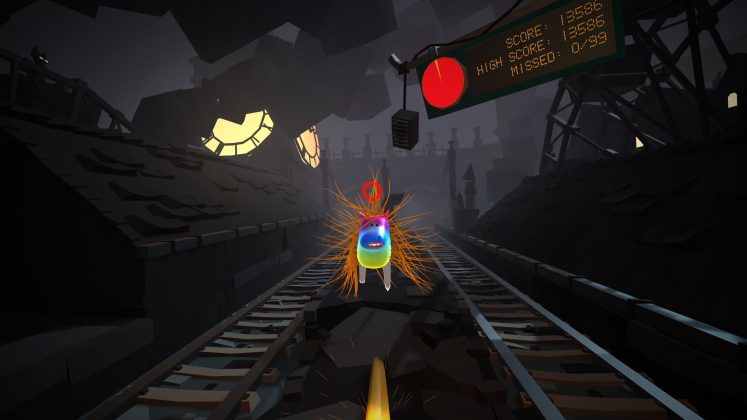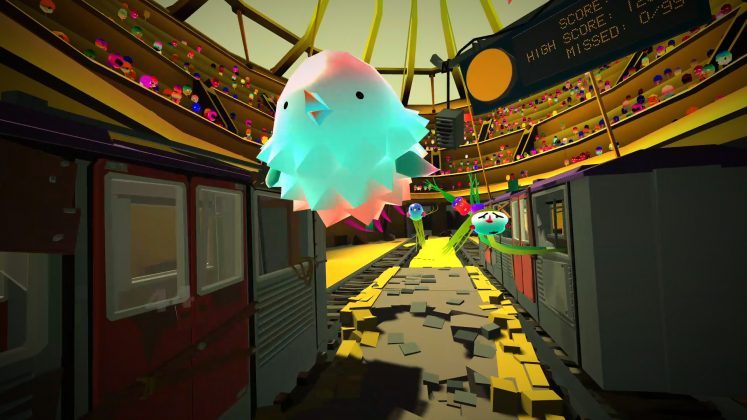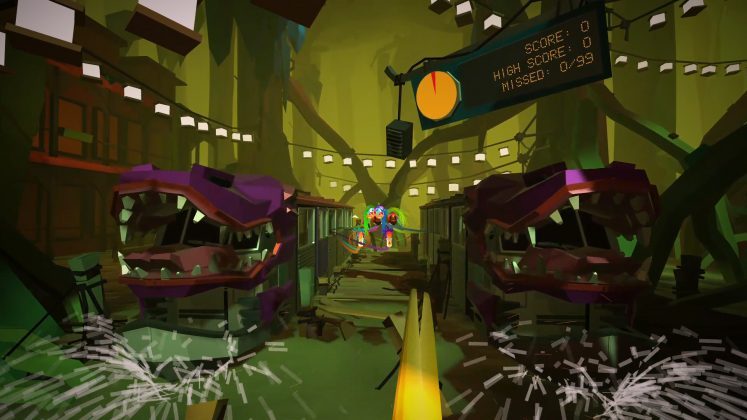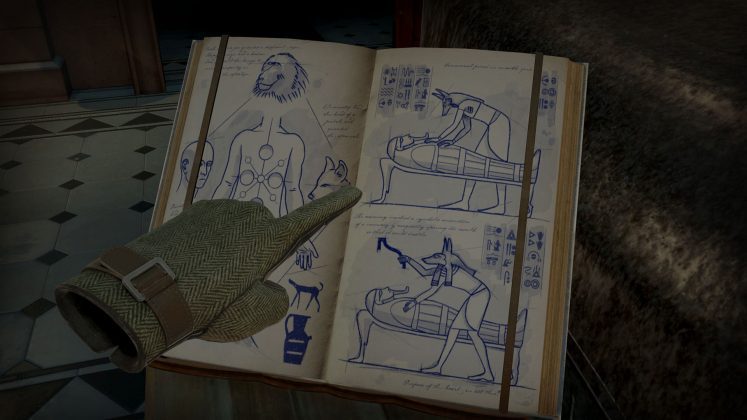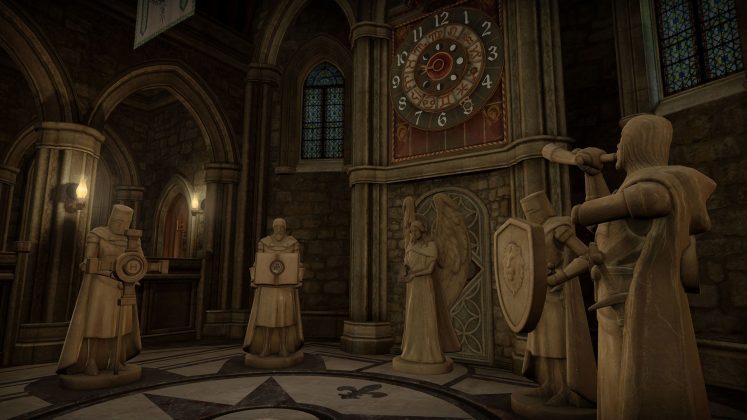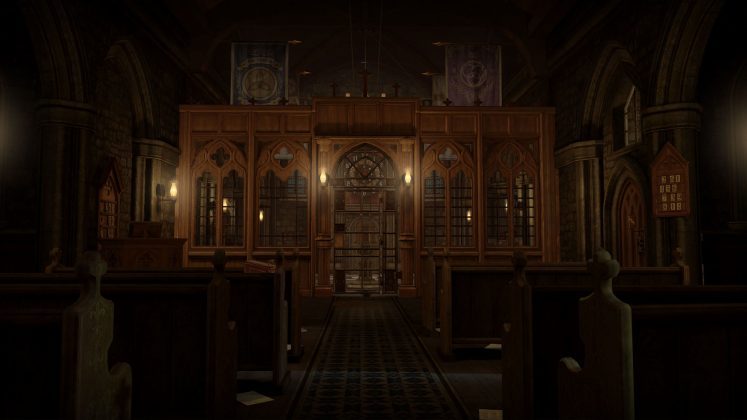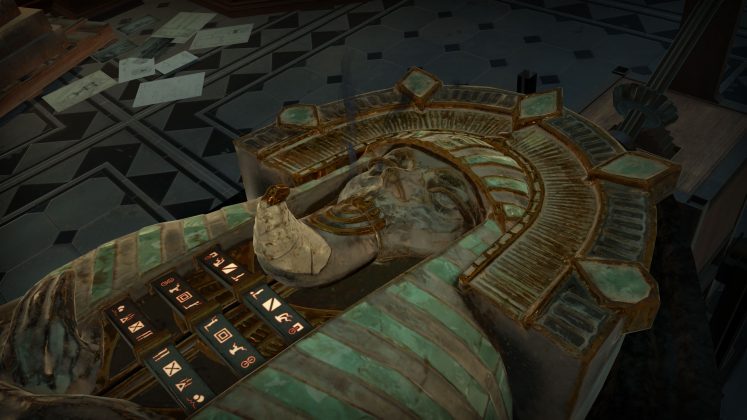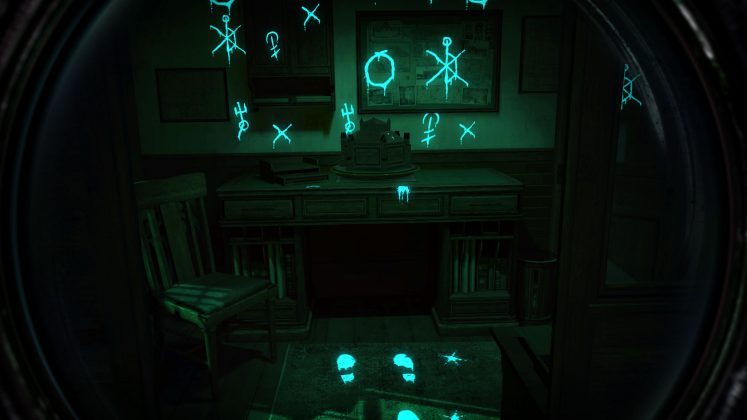Saturday, February 29, 2020
Let's Play VR Underwater Thriller FREEDIVER: Triton Down on Oculus Quest
FREEDIVER: Triton Down has just been released on the Oculus Quest & PSVR. This is an Extended Cut with more content! We'll check this out with a heart monitor... ► Check out our VR equipment → https://www.amazon.com/shop/caschary FREEDIVER: Triton Down is a single-player underwater adventure thriller released last year on PC VR. Now, an extended cut with more content has been released on Oculus Quest and PS VR. It features more gameplay coontent, features and a deeper story. Chary is a little bit scared of being in or on the water. Do you think I'm evil for putting her through this experience? This is our weekly Virtual Reality live stream. Our live streams are usually centered around one topic but we can talk about anything. Come hang out and let's discover VR worlds together. Today's topic(s): Latest VR news & FREEDIVER gameplay! SCHEDULE Every Friday at: 🕛 12 PM PT 🕘 9 PM CET 🕗 8 PM UK Time 🍿 Watch us from within Bigscreen VR too! LINKS OF TODAY'S EQUIPMENT * ► Get an Oculus Quest (US): https://amzn.to/2H5ECGx - Get an Oculus Quest (UK): https://amzn.to/2Jip6Zg - Get an Oculus Quest (NL): http://bit.ly/2QlCpd2 (Coolblue) ► Get FREEDIVER: Triton Down Extended Cut for Oculus Quest here → https://www.oculus.com/experiences/quest/2260701747375712/ ► Get the original FREEDIVER: Triton Down VR on Steam here → https://store.steampowered.com/app/995230/FREEDIVER_Triton_Down/ SUPPORT US Subscribing and watching our videos is by far the biggest support you can give us. However, if you want to do more - you can also donate. All donations go to improving the channel. BUY US A COFFEE & BOOST THE CHANNEL ► One-time donation → http://bit.ly/DonateCasandChary BECOME A CHAMPION (LONG-TIME SUPPORTER) ► Become our Patron (includes exclusive rewards) → http://bit.ly/PatreonCasandChary ► Become a Sponsor on YouTube (includes exclusive rewards) → http://bit.ly/JoinCasandChary USE OUR LINKS TO SUPPORT US ► VRcover → http://bit.ly/CCVRCover ► VR Prescription Lens Adapters (5% discount code: "CAS&CHARY") → http://bit.ly/CCWidmoVR ► Play PC VR games with your Quest (10% discount code: "JWGTCASCHARY") → http://bit.ly/CCRiftcat ► More on our website → https://casandchary.com/discount-codes-affiliate-links/ OUR GEAR Our VR equipment → https://www.amazon.com/shop/caschary Full PC Specs → https://casandchary.com/vr-equipment/ GET LATEST UPDATES Twitter → https://twitter.com/CasandChary Facebook → https://www.facebook.com/casandchary/ Instagram → https://www.instagram.com/casandchary/ Join our Discord → https://discord.gg/YH52W2k A special thanks to these Patreon Champs for their support: - artArmin - BaxornVR - Wintceas - Studioform VR - Ztreak - Albert - Ben P. MUSIC Music we use is from Epidemic Sounds → http://share.epidemicsound.com/zqM3g DISCLAIMER Links in this description may contain affiliate links. You don't have to use them, but if you do, a small referral fee will go to this channel supporting the content. VR on! - Cas and Chary VR #freedivertritondown #oculusquest #casandchary
Thursday, February 27, 2020
4 Oculus Quest HAND TRACKING Games You Should Try!
I have been having so much fun trying things with hand tracking on the Oculus Quest. So, of course, I want to share that with you. ► Check out our VR equipment → https://www.amazon.com/shop/caschary ► Subscribe to see more videos like this one → https://goo.gl/bSJ6L8 Things have changed ever since the Oculus Quest controller-free hand tracking came out. New updates... and developers have been experimenting with it! So in this short video, I’ll quickly update you on what’s been going on and show you some fun hand tracking games that you can try yourself. These games are also really fun and easy to show off Virtual Reality to friends and family. TIMESTAMPS 00:01 - Intro 00:37 - Hand tracking info & updates 02:07 - Sun Shard 04:07 - Cubism 06:05 - Interdimensional Matter 07:19 - Mr. Scribbles LINKS - SideQuest setup guide: https://youtu.be/SDljN6UqO34 - VRtuos: VR piano learning app: https://youtu.be/_8VqQfrHG94 - Sun Shard Hand Tracking Demo - Might of the Gods: https://sidequestvr.com/#/app/400 - Cubism VR [Experimental hand tracking support]: https://sidequestvr.com/#/app/403 - Interdimensional Matter - https://sidequestvr.com/#/app/506 - Mr. Scribbles - https://sidequestvr.com/#/app/444 - Get an Oculus Quest (US): https://amzn.to/2H5ECGx - Get an Oculus Quest (UK): https://amzn.to/2Jip6Zg - Get an Oculus Quest (NL): http://bit.ly/2QlCpd2 (Coolblue) SUPPORT THE CONTENT ► Become our Patron (includes exclusive rewards) → http://bit.ly/PatreonCasandChary ► Become a Sponsor on YouTube (includes exclusive rewards) → http://bit.ly/JoinCasandChary ► Check out our VR Merch → http://bit.ly/casandchary-merch USE OUR LINKS TO SUPPORT US ► VRcover → http://bit.ly/CCVRCover ► VR Prescription Lens Adapters (5% discount code: "CAS&CHARY") → http://bit.ly/CCWidmoVR ► Oculus Quest Comfort Strap (5% discount code: "CAS&CHARY") → http://bit.ly/CCStudioformVR ► Play PC VR games with your Quest (10% discount code: "JWGTCASCHARY") → http://bit.ly/CCRiftcat ► More on our website → https://casandchary.com/discount-codes-affiliate-links/ OUR GEAR Our VR equipment → https://www.amazon.com/shop/caschary Full PC Specs → https://casandchary.com/vr-equipment/ GET LATEST UPDATES Twitter → https://twitter.com/CasandChary Facebook → https://www.facebook.com/casandchary/ Instagram → https://www.instagram.com/casandchary/ Join our Discord → https://discord.gg/YH52W2k A special thanks to these Patreon Champs for their support: - artArmin: https://store.steampowered.com/app/728110/Board_Games_VR/ - BaxornVR: https://www.youtube.com/channel/UC1tmq8Y3jC7gNGvW7asmv1Q - Wintceas - Studioform VR - Andy - Albert - Ben P. - Steve Dunlap MUSIC Music we use is from Epidemic Sounds → http://bit.ly/CCEpidemicSound DISCLAIMER Links in this description may contain affiliate links. A small referral fee will go to the channel if you use it which supports the content. VR on! - Cas and Chary VR #oculusquest #handtracking #casandchary
‘The Room: A Dark Matter’ Coming to All Major VR Headsets in Late March, Trailer Here
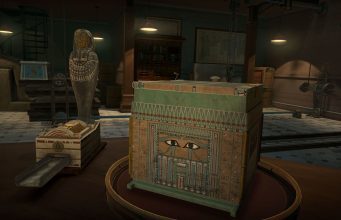
Fireproof Games, the studio behind popular puzzle title The Room (2014), today announced its first VR entry into the franchise—The Room: A Dark Matter—is slated to arrive next month on PC VR headsets, Oculus Quest, and PSVR.
Fireproof says in a tweet that the game will be landing simultaneously on their respective stores on March 26th. The studio also pushed out a new trailer, which we linked below.
In case you haven’t been following along, The Room: A Dark Matter is an upcoming VR puzzle game that promises to deliver on the franchise’s knack for complex, escape room-style puzzles. The original The Room for PC has managed to nab itself a solid [10/10] user rating on Steam, so it’s clear Fireproof has big shoes to fill here.
We had a chance to preview the game on Oculus Quest earlier this week, and it proved to be not only to serve up engaging and cleverly-built puzzles, but an engrossing visual experience to compliment its dark, Lovecraftian story. Although we haven’t played on PSVR or PC VR headsets yet, the Quest version left us sufficiently wowed enough to say that it’s set a new bar for VR puzzle games.
Make sure to check out our spoiler-free preview, linked above, to learn a little more about why we’re so excited for others to play The Room: A Dark Matter.
The post ‘The Room: A Dark Matter’ Coming to All Major VR Headsets in Late March, Trailer Here appeared first on Road to VR.
Ream more: https://www.roadtovr.com/room-dark-matter-launch-psvr-quest-rift-vive-steam-vr/
Mind-bending VR Art Showcase ‘Museum of Other Realities’ Exits Early Access
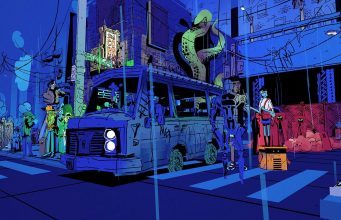
The Museum of Other Realities (MOR) first launched into Early Access on PC VR headsets in June 2019, bringing with it a curated selection of multi-sensory art pieces from some of the medium’s most talented illustrators, animators, and engineers. Now, the group of artists behind the space has officially released MOR out of Early Access with its 1.0 update.
The MOR, a social VR experience at its core, houses a growing collection of interactive art and experiments from the likes of some familiar names in both the VR game & art scene, including Rosie Summers, Kevin Mack, Danny Bittman, Isaac Cohen, Liz Edwards, Nick Ladd, and Vladimir Ilic. Check out the full list of contributing artists here.
In a recent blog post, the artist group calls the 1.0 update “one of the biggest updates […] made to the MOR,” which includes new architecture, art, and some quality of life updates such as an improved avatar creation, wayfinding and navigation of the space.
If you’ve already popped into the MOR, its creators maintain that it “isn’t the MOR you remember, it’s much bigger and bolder, with a new design and artwork spanning two floors.”
“During our time in Early Access, we had the opportunity to hear from the community, which in turn, helped us iterate based on the valuable feedback we’ve received,” the developers say. “We’re also glad to have worked with so many amazing artists who have contributed so much to the MOR.”
The MOR team is said to have gone back and forth with its artists and architects over the last year to create a space that aims to “blow the audience away.” Along with the redesign, which increased the space significantly, its creators hope the MOR becomes a place always worth returning to as you discover more and more.
As a paid app costing $20, the creators say The MOR was designed to support artists “who are challenging and redefining what is possible with virtual reality art.” You can find it on Steam and Viveport, supporting HTC Vive, Oculus Rift, and Valve Index.
The post Mind-bending VR Art Showcase ‘Museum of Other Realities’ Exits Early Access appeared first on Road to VR.
Ream more: https://www.roadtovr.com/mind-bending-vr-art-showcase-museum-realities-exits-early-access/
Wednesday, February 26, 2020
Hellish VR Shooter ‘A-Tech Cybernetic’ is Making Its Way to PSVR Next Month
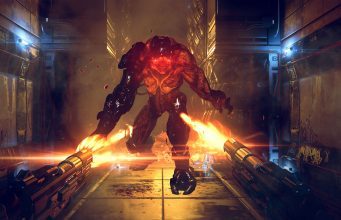
Hungary-based indie studio XREAL Games today announced its Early Access VR shooter, A-Tech Cybernetic VR, is headed to PSVR sometime next month.
XREAL developer Daniel Nyirfa took to the PSVR subreddit today, commenting that although translating the PC VR game to the PSVR has been challenging, the game now has a March launch window. There’s no specific launch date yet, although it’s likely one will materialize soon.
First launched on Steam in mid-2017 and then later on the Oculus Store for Rift a year later, A-Tech Cybernetic includes both a classic swarm mode against the game’s decidedly Doom-inspired mutant enemies and a story mode that takes you through a futuristic biomedical company.
The game most recently received its last two concluding chapters in a content update in October 2019 which also brought with it an overhaul of the gameplay and combat intensity throughout the whole game, making the game more difficult overall.
XREAL is also known for its Early Access VR shooter Zero Caliber VR.
The post Hellish VR Shooter ‘A-Tech Cybernetic’ is Making Its Way to PSVR Next Month appeared first on Road to VR.
Ream more: https://www.roadtovr.com/a-tech-cybernetic-psvr-launch-date-march/
Sketchfab Launches Public Domain Program so Museums Can Share Cultural Relics in 3D
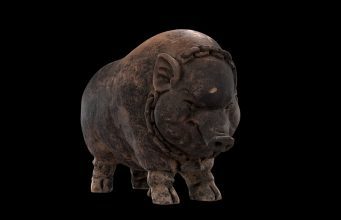
Sketchfab is a great resource for developers looking for a place to share and download 3D models—all of which can be viewed in VR headsets. Now, the company has launched a new program that makes it easier for museums and like-minded organizations to display and freely share 3D scans of their objects of cultural heritage.
According to a Sketchfab blog post, cultural organizations can now dedicate their 3D scans and models to the Public Domain using the Creative Commons (CC) 0 Public Domain Dedication, which essentially certifies that the institution is gifting the work to the public domain by waiving all rights to the work worldwide under copyright law. This essentially lets anyone copy, modify, and distribute the work, even for commercial purposes, all without asking permission.
To accomplish this, Sketchfab has partnered with 27 such organizations from 13 different countries, including the Smithsonian, the National Gallery of Denmark, Chile’s Museo Nacional de Historia Natural, and the Cleveland Museum of Art to name a few.
Check out some of the digital objects below, many of which appear to be created using photogrammetry, a technique of stitching together photos into a 3D model:
If you have a PC VR headset, Oculus Quest or Oculus Go, you can take a gander in VR too.
Note: For PC VR headset users, you may want to use a dedicated VR web browser such as Supermedium on Steam or the native browser on the Oculus Store.
For users on Oculus Quest or Go, simply use the native Oculus browser. Navigate back to this page, load the asset and click the ‘View in VR’ button to get a more immersive view.
Alongside the new program, Sketchfab is also pushing an update to make it “even easier for 3D creators to download and reuse, re-imagine, and remix incredible ancient and modern artifacts, objects, and scenes,” says Thomas Flynn, Community & Cultural Heritage Lead at Sketchfab.
“This announcement is only just the start of Sketchfab’s support for CC0—we expect and invite more institutions to add 3D models to the public domain via the CC0 dedication in the future. If you work at a museum, gallery, or archive and want help dedicating your organisation’s 3D models to the Public Domain, please get in touch,” Flynn says.
The company is also highlighting how developers can incorporate this classic and ancient 3D data with some really interesting remixes.
Here’s the full list of participating cultural organizations. At the time of this writing there are currently over 1,700 3D scans, all of which you can view here.
- AD&D 4D, ES
- Arms Museum, RU
- Cleveland Museum of Art, US
- Digital Archive of Natural History (DiNArDa), DE
- Digital Atlas of Ancient Life at the Paleontological Research Institution, US
- Digital Heritage Age, Digital Counties Project, EI
- Faroe Islands National Museum, DK
- Ingenium, CA
- Jena – Lichtstadt, DE
- Minneapolis Institute of Art, US
- Morbase Museu Virtual, PT
- Musée Saint-Raymond, FR
- Museus de Sitges, ES
- Museo Nacional de Historia Natural de Chile, CL
- Niederösterreich 3D, AT
- RLA Archaeology, US
- Science Museum Group, UK
- Scottish Maritime Museum, UK
- The Smithsonian Institution, US
- SMK – National Gallery of Denmark, DK
- State Darwin Museum, RU
- Sterlitamak BashSU Archaeological Museum, RU
- The Cable Center, US
- University of Dundee Museum Collections, UK
- Världskulturmuseerna, SE
- Virtual Curation Lab, US
- Western Science Center, US
The post Sketchfab Launches Public Domain Program so Museums Can Share Cultural Relics in 3D appeared first on Road to VR.
Ream more: https://www.roadtovr.com/sketchfab-public-domain-3d-assets/
Tuesday, February 25, 2020
Microsoft Says it Hasn’t Given up on the VR Side of Windows Mixed Reality
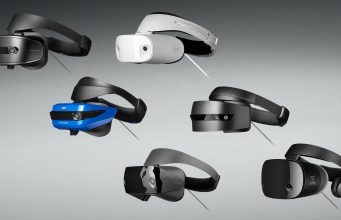
While Microsoft has been full steam ahead on the augmented reality side of Windows Mixed Reality via HoloLens, the company has had very little to say in the last year about the VR side of its platform. While it may look like Microsoft has largely given up on the effort, the company tells us that it remains committed.
In late 2017 Microsoft launched its Windows Mixed Reality platform, a software foundation built into Windows 10 which supports VR headsets. The company also convinced a handful of its major PC partners—Dell, Lenovo, Acer, HP, Samsung, and Asus—to launch VR headsets attached to the platform.
For the most part all of those headsets offered up identical specs, with the only differences being in outward design (Samsung went a bit further with different displays and lenses), leaving little to differentiate them. Though the Windows VR headsets were the first out of the gate with inside-out tracking, they struggled to compete with incumbents on consumer value, especially in the content department, with many users skipping the Microsoft Store in favor of the much richer content library of SteamVR.
The headsets saw some traction initially, especially as retail discounts made them an attractive budget option. Windows VR headsets peaked at 11.13% of the share of headsets in use on Steam in June 2019, but have been slowly declining since then, down to 8.05% as of January, 2020.
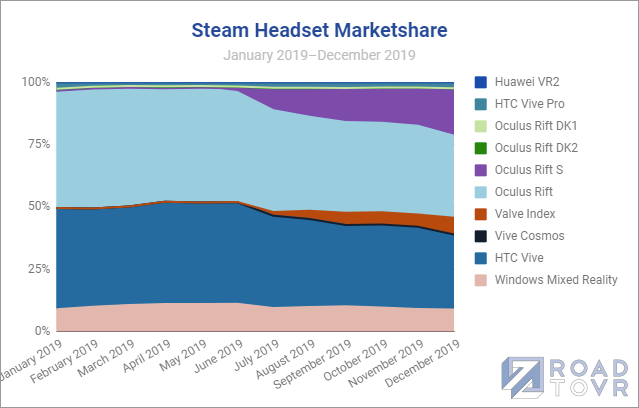
Only two of the initial five Windows VR headset makers followed up their initial headsets with new consumer-facing devices (Samsung’s Odyssey+ and HP’s Reverb). Though they brought some improvements to the table, there’s a widespread feeling that essential elements of these headsets—the tracking and controllers—are ‘last-gen’ compared to contemporary devices.
It’s those very elements which Microsoft has not moved forward since the launch of the Windows VR headsets in late 2017. As the key contributor of the initial reference design (which includes the inside-out tracking system and corresponding controllers) that the Windows VR headsets were based on, Microsoft has shown little interest in modernizing the system so that headsets from its partners can better compete with the likes of Facebook, Valve, and HTC.
But has Microsoft simply given up on Windows VR? You might think so, given the silence over the last year, the apparent discontinuation of all of the original WMR headsets, and the cancellation of Acer’s latest Windows VR headset.
But Microsoft maintains it’s still actively invested in Windows VR. When pressed on the matter—including questions about plans to modernize the tracking system for increased coverage, improve the bulky controllers, and sort out the platform’s VR content strategy—Microsoft didn’t want to talk specifics, but assured us that it hasn’t given up.
“[…] Microsoft remains invested in improving the underlying [hardware] platform, Windows Mixed Reality, and look forward to what the future will hold for the industry,” a spokesperson told Road to VR. “We continue to believe that end-users will be interested in taking part in mixed reality through a variety of different entry points along the spectrum, inclusive of virtual reality, augmented reality and everything in between.”
The company also remains committed to the Windows Mixed Reality plugin for SteamVR, which is the essential bridge that allows Windows VR headsets to access Steam content, including the upcoming Half-Life: Alyx.
“As we discussed at MWC 2019,” the spokesperson said, “we continue to develop with the idea of #Open at the forefront—in which we believe that for an ecosystem to truly thrive there should be no barriers to innovation or customer choice.”
It’s not much to go on, but Microsoft tells us there’s more to come for Windows VR, and it’ll have more to say when the time is right.
The post Microsoft Says it Hasn’t Given up on the VR Side of Windows Mixed Reality appeared first on Road to VR.
Ream more: https://www.roadtovr.com/microsoft-not-giving-up-on-windows-vr-wmr-windows-mixed-reality/
Facebook Acquires the VR Studio Behind ‘Asgard’s Wrath’, Sanzaru Games

Just a few months after the acquisition of Beat Saber studio Beat Games, Facebook today announced the acquisition of Sanzaru Games, the studio behind the Oculus-exclusive Asgard’s Wrath and a handful of other VR titles. Sanzaru will join Facebook’s VR game division, Oculus Studios, but continue to be run as an “independently operated studio.”
 As far as VR studios go, Sanzaru Games is one of the most veteran you’ll find. The studio began working with Facebook’s Oculus before the company even shipped its first consumer headset. Sanzaru’s first VR title was Ripcoil (2016), built as an Oculus Rift launch title back before the headset was bundled with its ‘Touch’ motion controllers.
As far as VR studios go, Sanzaru Games is one of the most veteran you’ll find. The studio began working with Facebook’s Oculus before the company even shipped its first consumer headset. Sanzaru’s first VR title was Ripcoil (2016), built as an Oculus Rift launch title back before the headset was bundled with its ‘Touch’ motion controllers.
Sanzaru continued to build Oculus-exclusive titles published by Oculus Studios; there was VR Sports Challenge (2016), a Touch launch title, followed by Sanzaru’s first major production, Marvel Powers United VR (2018). The studio’s crowning achievement, so far, is Asgard’s Wrath (2019), a VR RPG which received wide acclaim, including our 2019 Game of the Year Award.
Over the years, and thanks in large part to development deals from Oculus Studios, Sanzaru Games has honed its talents as a VR developer, one of only a handful of independent studios which has proven it can successfully deliver a project with the scope of Asgard’s Wrath. With few studios equipped to work in VR at this scale, Sanzaru is a valuable asset for any company wanting to ensure the best VR content comes to their platform.
And that’s likely the primary reason behind Facebook’s acquisition of Sanzaru Games; after years of investing in large projects which have honed the studio’s VR chops, Oculus Studios doesn’t want to risk a competitor coming in and snatching up all that talent for their own platform-exclusive content (much like what happened with Stormland developer Insomniac Games, which was acquired by Sony last year).
Before VR, Sanzaru has worked on a handful of non-VR games dating back to 2008. Going forward, the plan is to be fully focused on VR. Facebook didn’t announce the terms of the acquisition, but says that “Sanzaru is joining Facebook to help us pursue a future of rich, immersive, and original VR game content,” and maintains that the studio will be operated “independently” out of its existing offices.
Facebook says it isn’t ready to talk about what projects are next on the docket for Sanzaru, nor whether they will focus on Quest, Rift, or both, but it seems certain from here on out that future VR games from Sanzaru will continue to be Oculus-exclusive.
Are there more VR studio acquisitions to come? Facebook won’t say for now, but teases, “we’re exploring many ways to accelerate VR, and 2020 is going to be an incredible year for VR game launches and announcements. We are thrilled to have Sanzaru joining our team. This is just one of the many amazing VR announcements we have in store this year.”
The post Facebook Acquires the VR Studio Behind ‘Asgard’s Wrath’, Sanzaru Games appeared first on Road to VR.
Ream more: https://www.roadtovr.com/facebook-acquires-sanzaru-games-asgards-wrath-oculus-studios/
Can You Learn To Play The Piano With Virtual Reality?
VRTuos is a new & FREE VR piano learning app for the Oculus Quest. Let's check if it is actually possible to learn to play the piano with a VR headset! ► Check out our VR equipment → https://www.amazon.com/shop/caschary ► Subscribe to see more videos like this one → https://goo.gl/bSJ6L8 VRTuos is only available for the Oculus Quest because it uses hand tracking. In this video, both a novice and a more experienced piano player try out the app to see if you need some experience to learn the piano or that anyone can do it... TIMESTAMPS 00:01 - Video introduction 01:17 - VRTuos introduction 01:55 - VRTuos calibration with real piano 02:44 - Cas tries it out 04:11 - Chary tries it out 07:22 - Our final thoughts LINKS - VRTuos on SideQuest: https://sidequestvr.com/#/app/494 - How to sideload on Oculus Quest guide: https://youtu.be/SDljN6UqO34 - Get an Oculus Quest (US): https://amzn.to/2H5ECGx - Get an Oculus Quest (UK): https://amzn.to/2Jip6Zg SUPPORT THE CONTENT ► Become our Patron (includes exclusive rewards) → http://bit.ly/PatreonCasandChary ► Become a Sponsor on YouTube (includes exclusive rewards) → http://bit.ly/JoinCasandChary ► Check out our VR Merch → http://bit.ly/casandchary-merch USE OUR LINKS TO SUPPORT US ► VRcover → http://bit.ly/CCVRCover ► VR Prescription Lens Adapters (5% discount code: "CAS&CHARY") → http://bit.ly/CCWidmoVR ► Oculus Quest Comfort Strap (5% discount code: "CAS&CHARY") → http://bit.ly/CCStudioformVR ► Play PC VR games with your Quest (10% discount code: "JWGTCASCHARY") → http://bit.ly/CCRiftcat ► More on our website → https://casandchary.com/discount-codes-affiliate-links/ OUR GEAR Our VR equipment → https://www.amazon.com/shop/caschary Full PC Specs → https://casandchary.com/vr-equipment/ GET LATEST UPDATES Twitter → https://twitter.com/CasandChary Facebook → https://www.facebook.com/casandchary/ Instagram → https://www.instagram.com/casandchary/ Join our Discord → https://discord.gg/YH52W2k A special thanks to these Patreon Champs for their support: - artArmin: https://store.steampowered.com/app/728110/Board_Games_VR/ - BaxornVR: https://www.youtube.com/channel/UC1tmq8Y3jC7gNGvW7asmv1Q - Wintceas - StudioformVR - Andy - Albert - Ben P. - Steve Dunlap MUSIC Music we use is from Epidemic Sounds → http://bit.ly/CCEpidemicSound DISCLAIMER Links in this description may contain affiliate links. A small referral fee will go to the channel if you use it which supports the content. VR on! - Cas and Chary VR #vrpiano #oculusquest #casandchary
Qualcomm Reveals New Reference Designs for XR2-powered VR & AR Headsets
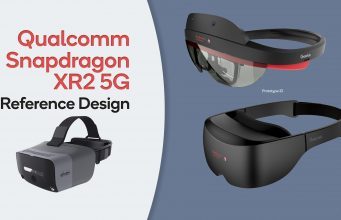
Qualcomm today revealed new reference designs for VR and AR headsets powered by its new Snapdragon XR2 chip. Complete with hand-tracking, magnetic controller tracking, eye-tracking, and more, the Qualcomm reference designs are a glimpse of what’s to come in AR and VR over the next year or two.
Qualcomm has been a quiet enabler of most major standalone AR and VR headsets on the market today. The company has its Snapdragon chips in more than 30 headsets—including major devices like Oculus Quest, Oculus Go, HoloLens 2, and Vive Focus—and it has its fingerprints on many of these headsets through the fruits of its HMD Accelerator Program which provides reference designs that act as blueprints for companies to quickly bring VR and AR headsets to market.
Today the company revealed its latest VR and AR headset reference designs which now include the company’s powerful new Snapdragon XR2 chip. The reference designs give us a clear idea of the specs and capabilities of standalone headsets that we’re likely to see over the next year or two.
The working XR2 reference design, also known as the VRDK, is a larger headset which serves as a testbed for partners to evaluate different features and capabilities. It’s bulky and quite basic looking, for ease of production, but crammed with features for testing.
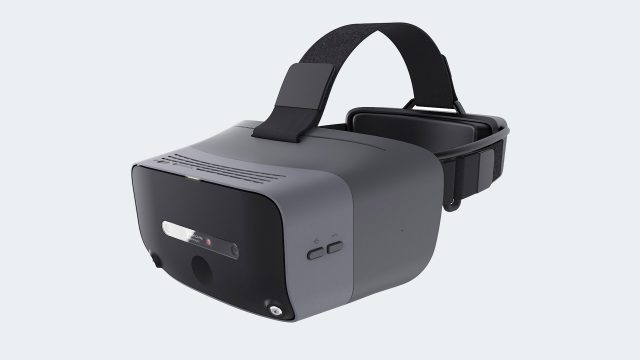 Late last year Qualcomm gave us a good idea of the kind of specs and features we could expect to see from VR headsets based on XR2; namely: displays up to 3K × 3K per eye @ 90Hz, integrated 5G connectivity, support for seven simultaneous camera feeds, and significantly more processing power across the board compared to Snapdragon 835 (one of the most common chipsets found in current standalone headsets, including Quest).
Late last year Qualcomm gave us a good idea of the kind of specs and features we could expect to see from VR headsets based on XR2; namely: displays up to 3K × 3K per eye @ 90Hz, integrated 5G connectivity, support for seven simultaneous camera feeds, and significantly more processing power across the board compared to Snapdragon 835 (one of the most common chipsets found in current standalone headsets, including Quest).
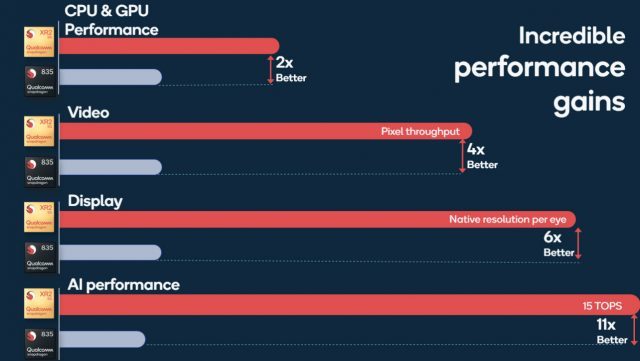
The company added today that the XR2 reference design can support controllerless hand-tracking (likely from Ultraleap), Atraxa magnetic controller tracking, and Tobii eye-tracking. While no one headset is likely to include everything, the features exist in the reference design for partners to evaluate and consider for inclusion in future headsets.
Qualcomm also showed off prototype industrial design references (one for VR and one for AR) which offer a glimpse of the kind of form-factors the company believes could be achieved for commercial products based on the XR2 reference design.
Qualcomm is also touting a “comprehensive, end-to-end solution” for cloud-rendered VR delivered over a 5G network. While the company had spoken about the possibility of cloud VR before, this is the first time it’s telling partners that it has all the pieces in place for anyone who wants to attempt to deliver a product built around the concept. Even if it all works in theory, such a device won’t really be feasible until 5G networks and (more importantly) EDGE computing are widely deployed.
The post Qualcomm Reveals New Reference Designs for XR2-powered VR & AR Headsets appeared first on Road to VR.
Ream more: https://www.roadtovr.com/qualcomm-snapdragon-xr2-reference-design-vrdk-vr-ar-headset/
‘FREEDIVER: Triton Down’ Arrives on PSVR Today in New ‘Extended Cut’
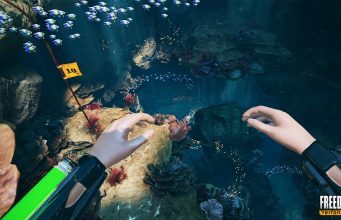
Archiact, the studio behind VR games Evasion (2018) and Waddle Home (2016), today launched its underwater adventure FREEDIVER: Triton Down (2019) on PSVR in a new ‘Extended Cut’ edition.
Freediver: Triton Down was decidedly pretty demure in scope when it first launched on on PC VR headsets back in May 2019, what with its one-hour playtime. Quick gameplay length notwithstanding, Freediver has striven to make up for its shortcomings with a number of good ideas such as an interesting ‘swimming’ locomotion system and the inherent tension of freediving in the deep without a mobile air supply.
Swimming, which is done via motion controller movement, not only allows you to seamlessly navigate the depths, but it also lends plenty of tension between movement and survival as the player is constantly looking for air whilst having to solve puzzles. The PSVR version only supports PS Move, so make sure to get on your floaties.
In a PlayStation blog post, Archiact’s Renee Klint explains that the ‘Extended Cut’ includes all-new levels on the ship, and a few new areas that have been plunged into darkness which adds what Klint calls “an extra layer of challenge to the many puzzles you’ll encounter.”
The new cut also includes a handy flashlight, although there are admittedly “some dangers in the depths that only a cool head and lightning reflexes will save you from,” Klint reveals. There’s also supposedly more items related to the ship’s fateful sinking such as lost audio logs of the crewmembers’ final days aboard.
While we don’t expect the ‘Extended Cut’ to push the gameplay length a ton, Freediver: Triton Down is now available on the PlayStation Store for $15, which sounds about right for a short but sweet adventure into the deep.
It’s uncertain when/if the ‘Extended Cut’ will arrive on other platforms in the form of a free update, or paid DLC. We’ve reached out to Archiact and will update this piece when we know more.
The post ‘FREEDIVER: Triton Down’ Arrives on PSVR Today in New ‘Extended Cut’ appeared first on Road to VR.
Ream more: https://www.roadtovr.com/freediver-triton-down-psvr-vr-archiact/
‘Bizarre Barber’ is a Surreal VR Game About Cutting Hair in a Post-apocalyptic Subway

Brooklyn-based studio Synesthetic Echo is nearly ready to release a charmingly weird new title that tasks you with snipping away at mutant mops tops in an otherworldly subway platform.
Called Bizarre Barber, the hair-styling game is set to release on Steam and Viveport on February 26th, 2020, which includes support for Oculus Rift, HTC Vive, and Valve Index.
In case the trailer hasn’t sufficiently piqued your interest, here’s the setup:
Bizarre Barber is a fast-paced, accessible action game for the Rift Platform set in a surreal world where you play as an alien barber providing stylish haircuts for eccentric clientele. Instead of a comfy adjustable chair you’d see in most barber shops, all of your clients move chaotically through the world unable to sit still even for a second. Players will make perfect cuts, dodge dangerous obstacles, catch speed boosts and power-ups, and even earn money to unlock new tools and new worlds.
The game is said to include seven unique worlds, 13 levels, several types of boosters such as sword-hands, leaderboards, boss fights, and its own interactive soundtrack. Bizarre Barber also boasts no artificial locomotion and both sitting and standing modes, something the studio says will appeal to both new and veteran VR users.
The development of Bizarre Barber was supported by the 2018 Oculus Launchpad program and NYU Game Center Incubator.
The post ‘Bizarre Barber’ is a Surreal VR Game About Cutting Hair in a Post-apocalyptic Subway appeared first on Road to VR.
Ream more: https://www.roadtovr.com/bizarre-barber-rift-vive-index-steam-vr/
More Than 100 VR Games Have Exceeded $1 Million in Revenue
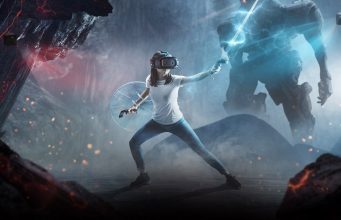
While VR is still young, it crossed an important milestone at the start of 2020: more than 100 VR games have exceeded $1 million in revenue.
In an analysis published earlier this month, VR Fund investor Tipatat Chennavasin made the case that 2019 was a significant inflection point for the VR industry.
Based on data gathered from the major VR storefronts—Steam, PlayStation Network, Oculus PC, & Oculus Rift—and insights from developers, Chennavasin estimates that a total of 106 VR games have exceeded $1 million in revenue. And nearly half of that has come in the last 12 months alone.
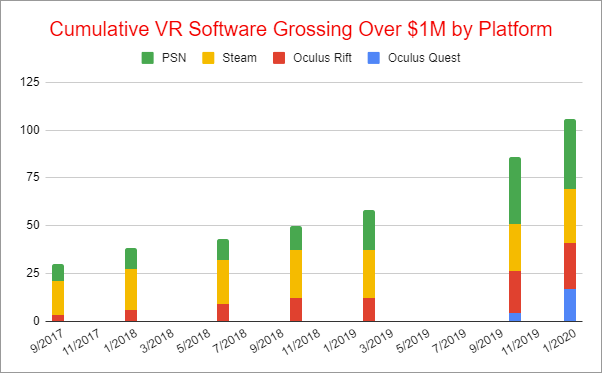 What’s more, among those 106 titles, some have rocketed past the $1 million milestone; Chennavasin reports that the top seven titles have exceeded $10 million in revenue, with the leading title pulling in a whopping $60 million. By this time next year, he expects, the first VR game could reach the $100 million milestone.
What’s more, among those 106 titles, some have rocketed past the $1 million milestone; Chennavasin reports that the top seven titles have exceeded $10 million in revenue, with the leading title pulling in a whopping $60 million. By this time next year, he expects, the first VR game could reach the $100 million milestone.
The number of titles reaching $1 million or more is a key data point, Chennavasin said, as it demonstrates that success in the VR space is repeatable; VR is no longer a developer’s playground, it’s a platform offering real opportunity.
As a whole, he estimates that VR game revenue in 2019 reached $300 million across platforms, a major boost compared to the years prior, driven partly by Quest but also by significant growth from the other major platforms as well.
See Chennavasin’s full report for more data and analysis on the state of VR today.
The post More Than 100 VR Games Have Exceeded $1 Million in Revenue appeared first on Road to VR.
Ream more: https://www.roadtovr.com/100-vr-games-exceeded-1-million-revenue/
Monday, February 24, 2020
Preview: ‘The Room: A Dark Matter’ Sets a New Bar for VR Puzzle Games
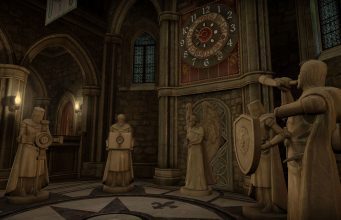
The Room: A Dark Matter is an upcoming VR puzzler from Fireproof Games, the same minds behind The Room (2014), its beloved predecessor for PC and mobile, and VR shooter-adventure Omega Agent (2016). With the fresh VR entry in franchise, Fireproof has shown a new level of mastery with the medium with this engaging, wondrous world of puzzles and arcane magic—something that truly sets a new bar for the VR puzzle genre.
Escape room games were one of the first to find a home in VR, and its for good reason: developers have a plethora of puzzle styles to borrow from both physical and digital escape rooms and mostly a blank check when it comes to the sort of story and visuals they want to drape on top of it. The object-oriented nature of the escape room genre is also basically a natural fit with VR thanks to motion controllers. That doesn’t put all VR escape rooms on equal footing though, as The Room: A Dark Matter strikes a satisfying balance between puzzle complexity, storyline delivery, atmosphere, and visuals, making for such an enjoyable time that I really didn’t want it to end.
I’m gushing. I know. But there’s plenty to gush about with The Room: A Dark Matter—especially because of what I saw on Quest. Here’s why:
Note: the is a spoiler-free preview of a pre-release version of The Room: A Dark Matter.
As per the game’s description, A Dark Matter begins deep within The British Museum in London, where the disappearance of an esteemed Egyptologist prompts a police investigation into the unknown. As an intrepid detective, you encounter cryptic locations, examine fantastic gadgets and discover an otherworldly element which blurs the line between reality and illusion.
At first I felt a bit like Indian Jones as I traipsed through a 12th century church to break my way into a crypt where I messed around with all sorts of Egyptian relics. But that Spielbergian flair soon wears thin as a more sinister, patently Lovecraftian vibe takes over. Although there aren’t any blatantly frightening bits to worry about (i.e. no jump scares or anything to grab at you), the atmosphere really starts to feel like something ripped from any one of H. P. Lovecraft’s occultist short stories, replete with locales you might envision springing from the late horror fiction writer’s Cthulhu Mythos. I won’t go any further so I don’t spoil the narrative.
The game’s linear story is punctuated with hand-written notes that you find along the way in a each level. These are useful to the overall story, but not in the sense that they will give you clues to how to solve your next puzzle. Rather, turning on your ‘spirit vision’ goggles, letters and notes take on a secondary function by letting you summon a ghostly view from the past for a short scripted interlude from some forgotten adventurer before you. More often than not, these apparitions leave behind key objects that start you out on your journey of deconstructing the game’s multi-layered puzzles. The goggles also reveal clues and other puzzles too, so you’ll find yourself toggling them on and off a bunch.
One of my favorite recurring puzzle is when you shrink down to fit into a keyhole, where you then go through a wide variety of cryptic mechanics to jimmy the lock open. I’m not certain why I’m able to shrink given the lack of context (uh, magic?), but I’m not sure it matters because of simply how impressive and inventive each puzzle was.
In some of the puzzles you’re tasked with fetching one item to unlock another, and these can be obvious from the onset. A dagger-shaped receptacle lets you unlock a box. A locked dagger is across the room that needs a key (etc). However as the game progresses, it’s very rarely a simple task of putting object ‘A’ into slot ‘B’, as puzzles become more complex and multi-faceted. Personally, the end result was real satisfaction and a sense that I was somehow clever when I solved a room, although I know it’s really both the puzzles and their designers that should get that compliment.
Outside of the game’s cleverly built puzzles, one of the most striking features of The Room: Dark Matter is its fantastic level of visual detail, which at many times felt like it was running on a much more powerful device (I played on Quest).
For example: the paper in my hand flops around as if it were actually effected by gravity. The green potion in my glass swirls around the container as I slosh it around plaintively. Lighting is excellent and the sheer volume of well-made textures really helps sell each room. Sometimes this high level of realism is infringed upon by the lack of full physics simulation; i.e. you can clip your hands through walls and doors, and only some objects are grabbable—it’s hard to tell what you can manipulate and what you’ll clip through, as the game only gives you a slight haptic buzz to tell you whether you’ve landed on something ‘solid’ or not. While this irks me a bit from an immersion standpoint, it never spoiled the game which was overall an awesome gameplay experience.
Puzzle hints enabled by default, but you can toggle them off in the main menu. If you leave them on you’ll still need to manually request a hint in the in-game inventory, so you never feel like it’s leading you by the hand unless you’re absolutely need it to. That’s where you’ll find your spirit goggles and all of the stuff you squirrel away in each level.
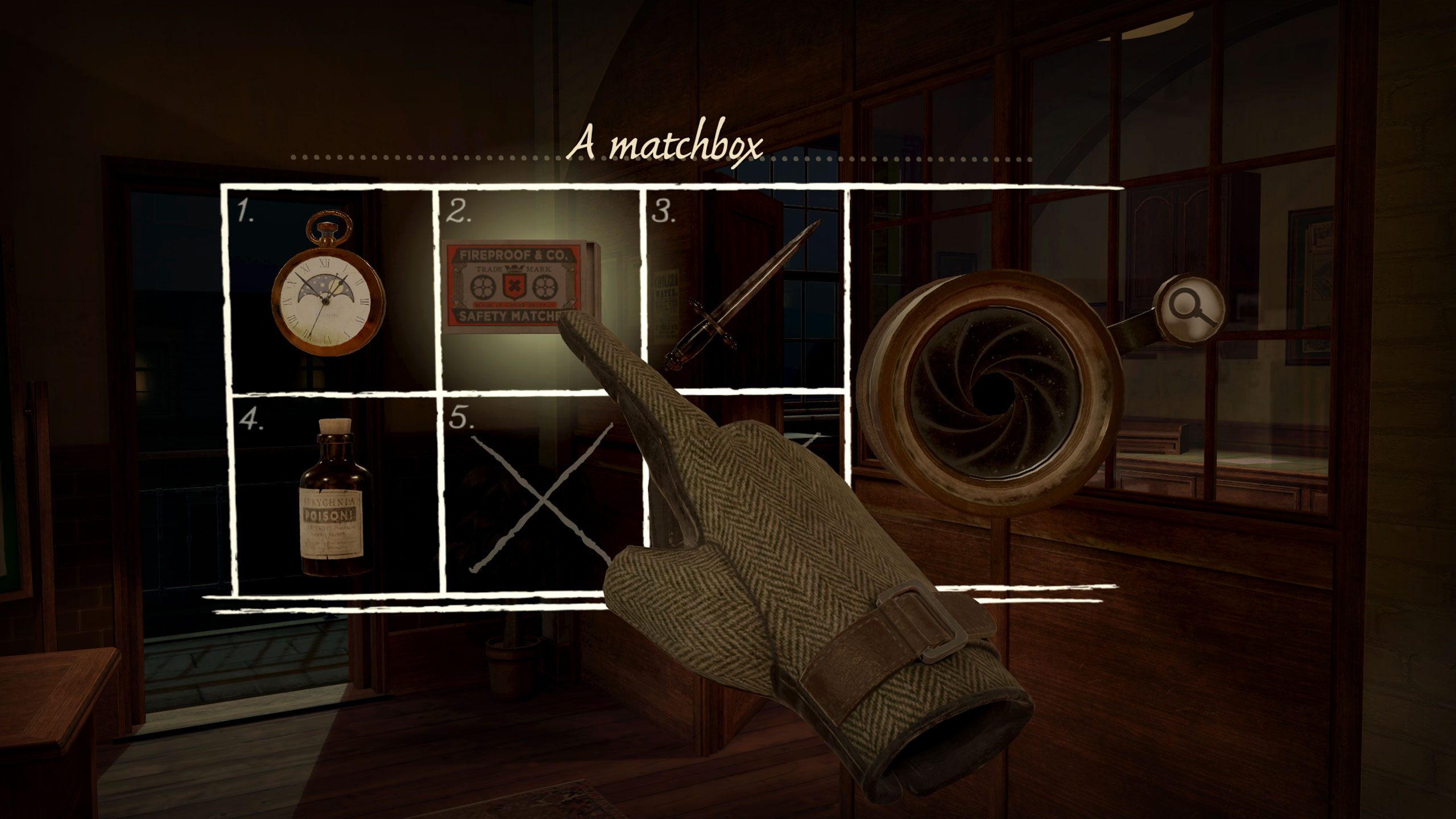
I’ve played my fair share of VR puzzle games that assume that I really simply must hear a hint every time I get something wrong, be it from an intrusive text bubble or a ‘helpful’ disembodied voice, and I can’t stress enough how much I hate being rushed through a puzzle when the entire point of a game is to let me solve it myself. A Dark Matter has really nailed that refreshing ‘hands-off’ approach, leaving you space to feel clever when you finally figure out some of the more complex puzzles by yourself. It took me a little over four hours to play, and I had a blast every step of the way.
One of the things I can see bothering some people (namely the anti-teleport crowd) is that The Room: A Dark Matter is teleport-only; you highlight nodes and ‘blink’ teleport over. I understand the need for this once you near the middle of the game and you have to traverse back and forth between puzzles often. Node teleportation also clues you into what’s important and what’s essentially just hollow scenery, which saves you from poking around needlessly. One thing I would have liked was the ability to turn off blink-style snap rotation, which is the only way to change your orientation outside of physically looking in the desired direction. Not a big deal if you’re playing standing, but it can feel a bit too jarring if you plan on playing seated.
In the end, I really hope Fireproof can garner the same level of success that prior entries in the franchise have, because I can’t wait to play more of their finely crafted escape rooms in VR.
The Room: A Dark Matter is slated to release sometime in Spring 2020 on Oculus Quest, PSVR, Oculus Rift, HTC Vive, Valve Index & Windows Mixed Reality headsets. Check out the game’s Steam page for more info.
The post Preview: ‘The Room: A Dark Matter’ Sets a New Bar for VR Puzzle Games appeared first on Road to VR.
Ream more: https://www.roadtovr.com/preview-the-room-a-dark-matter-vr/
Vive Cosmos Elite Pre-orders Start Today, Release Date Set for March 18th
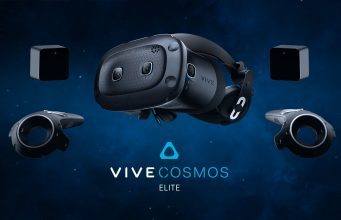
Last week HTC announced the full Vive Cosmos lineup which saw the introduction of three new variants which each use faceplates with different capabilities. Cosmos Elite, the high-end variant which uses SteamVR Tracking, opens for pre-orders as of today, with a release date of March 18th.
For the full breakdown of the Cosmos series, which now includes the Cosmos Play, Cosmos, Cosmos Elite, and Cosmos XR, see our reveal coverage here.
Like all of the Cosmos headsets, Cosmos Elite is built on the same core foundation, which means the same flip-up head-mount design, fresnel lenses, and 1,440 × 1,700 LCD displays with hardware IPD adjustment. But Cosmos Elite is designed to appeal to VR enthusiasts who want to leverage the power of SteamVR Tracking, the same Valve-made external tracking tech which has powered all of HTC’s PC VR headsets prior to Cosmos.
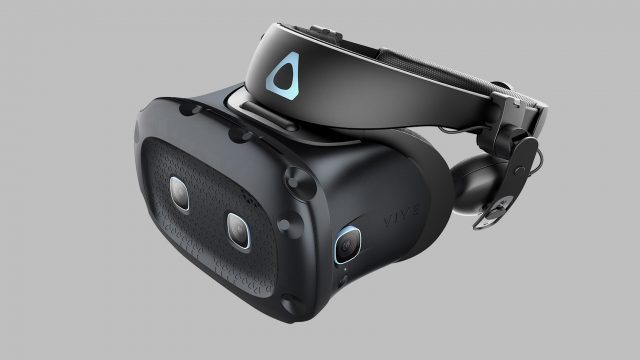
While Cosmos Elite is technically capable of the same level of inside-out tracking as other Cosmos headsets, the Elite comes with a unique faceplate which is covered in sensors that detect tracking signals from two external base stations. Though it doesn’t have the convenience of inside-out tracking, SteamVR Tracking is widely considered a gold-standard for VR tracking thanks to its speed, accuracy, coverage, and robustness to varying lighting conditions.
Since Cosmos Elite uses SteamVR Tracking, it doesn’t use the same controllers as the other Cosmos headsets; instead it uses the Vive wand controllers which launched with the original Vive.
Vive Cosmos Elite Price, Pre-orders, and Release Date
Priced at $900, Cosmos Elite includes the headset, two SteamVR Tracking 1.0 base tations (1.0), and two Vive wand controllers.
Pre-orders for the headset will start on the company’s website today, while the Vive Cosmos Elite release date is set for March 18th, just ahead of the release of Half-Life: Alyx on March 23rd.
The post Vive Cosmos Elite Pre-orders Start Today, Release Date Set for March 18th appeared first on Road to VR.
Ream more: https://www.roadtovr.com/vive-cosmos-elite-price-release-date-pre-order/
Sunday, February 23, 2020
Linden Lab Planning to Spin Off ‘Sansar’ to Refocus on ‘Second Life’

Sansar, Linden Lab’s VR-capable Second Life follow-up, is being spun out, the company’s CEO has confirmed.
First launched in beta in mid-2017, Sansar was Linden Lab’s first VR-native attempt at a virtual world platform. Designed to allow creators to build and host virtual worlds and experiences for other to visit, the platform struggled to gain traction and notoriety among VR users. By 2019 the studio was dialing back its emphasis on Sansar as a VR-centric platform in an effort to draw non-VR users to the platform as well.
More recently Sansar has been rebranded as a “new live events destination from the makers of Second Life,” with an emphasis on virtual performances.
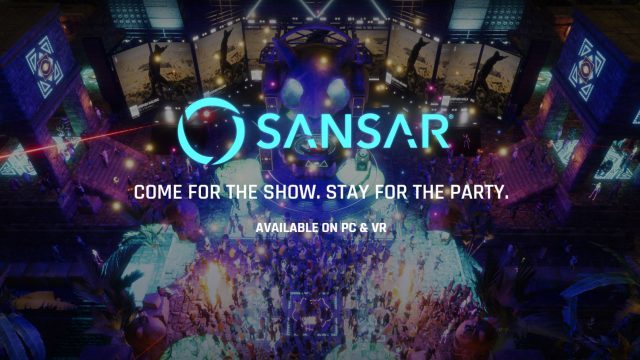
Now Linden Lab plans to spin Sansar out of the company. As spotted by New World Notes, CEO Ebbe Altberg said as much in a company livestream last week.
“[…] we have decided that as Linden Lab we couldn’t continue to sponsor [Sansar] financially, so we’re looking for a ‘plan B’ for Sansar to continue. I can’t say much but we’re having very interesting conversations with several parties to help that project move forward, which I’m really excited about. But no deal is done yet so people just have to be patient and see what happens with it,” he said.
Second Life may be 16 years old and past its heyday, but it remains one of the most active virtual worlds out there with a concurrent usership in the neighborhood of 40,000 users and an active economy. While there have been some attempts to make Second Life VR-compatible, it’s fundamentally not build for use with VR headsets.
While Linden Lab said from the start that Sansar wasn’t meant to be ‘Second Life 2‘, it was clear from the attention given to it that the company hoped Sansar would be its next big thing. But now, Altberg says, the company will refocus its efforts on Second Life.
“But yes it’s true that Linden Lab going forward will focus entirely on Second Life and Tilia. I’m still busy making sure Sansar finds a great home and that the great work that that team started can continue. That’s where things are are, hopefully we can be more specific on what’s going on in the next couple of weeks or so.”
While some VR-focused virtual worlds, like VRChat, have found ongoing traction, many others have not, including High Fidelity, a VR virtual world platform founded by Philip Rosedale (who, interestingly, was the founder of Second Life). After raising some $70 million over the years, High Fidelity announced in mid-2019 that it would lay off 25% of its staff and switch its focus from VR to becoming a platform for remote workers, at least until the VR audience grows large enough for the company’s focus.
The post Linden Lab Planning to Spin Off ‘Sansar’ to Refocus on ‘Second Life’ appeared first on Road to VR.
Ream more: https://www.roadtovr.com/sansar-spin-off-linden-lab-refocus-second-life/
Saturday, February 22, 2020
MEETING THE CULT - Let's Play The Walking Dead: Saints & Sinners VR with Oculus Quest #2
We continue The Walking Dead: Saints & Sinners, this time on the Oculus Link for Quest & with a heart monitor. Let's see how scared Cas can get from VR games. ► Check out our VR equipment → https://www.amazon.com/shop/caschary We love this VR game a lot! We would love to finish it with you, we will try to play each part with different headsets too to see if there's any difference. Let's see how far we can get in The Walking Dead: Saints & Sinners VR. ► Watch part 1 here: https://youtu.be/yUstDz5-1GQ This is our weekly Virtual Reality live stream. Our live streams are usually centered around one topic but we can talk about anything. Come hang out and let's discover VR worlds together. Today's topic(s): Recent VR news + The Walking Dead: Saints & Sinners VR gameplay on Oculus Quest with Oculus Link SCHEDULE Every Friday at: 🕛 12 PM PT 🕘 9 PM CET 🕗 8 PM UK Time 🍿 Watch us from within Bigscreen VR too! LINKS OF TODAY'S EQUIPMENT * ► Get an Oculus Quest (US): https://amzn.to/2H5ECGx - Get an Oculus Quest (UK): https://amzn.to/2Jip6Zg - Get an Oculus Quest (NL): http://bit.ly/2QlCpd2 (Coolblue) ► Get The Walking Dead: Saints & Sinners VR on Steam here → https://store.steampowered.com/app/916840/The_Walking_Dead_Saints__Sinners/ SUPPORT US Subscribing and watching our videos is by far the biggest support you can give us. However, if you want to do more - you can also donate. All donations go to improving the channel. BUY US A COFFEE & BOOST THE CHANNEL ► One-time donation → http://bit.ly/DonateCasandChary BECOME A CHAMPION (LONG-TIME SUPPORTER) ► Become our Patron (includes exclusive rewards) → http://bit.ly/PatreonCasandChary ► Become a Sponsor on YouTube (includes exclusive rewards) → http://bit.ly/JoinCasandChary USE OUR LINKS TO SUPPORT US ► VRcover → http://bit.ly/CCVRCover ► VR Prescription Lens Adapters (5% discount code: "CAS&CHARY") → http://bit.ly/CCWidmoVR ► Play PC VR games with your Quest (10% discount code: "JWGTCASCHARY") → http://bit.ly/CCRiftcat ► More on our website → https://casandchary.com/discount-codes-affiliate-links/ OUR GEAR Our VR equipment → https://www.amazon.com/shop/caschary Full PC Specs → https://casandchary.com/vr-equipment/ GET LATEST UPDATES Twitter → https://twitter.com/CasandChary Facebook → https://www.facebook.com/casandchary/ Instagram → https://www.instagram.com/casandchary/ Join our Discord → https://discord.gg/YH52W2k A special thanks to these Patreon Champs for their support: - artArmin - BaxornVR - Wintceas - Studioform VR - Ztreak - Albert - Ben P. MUSIC Music we use is from Epidemic Sounds → http://share.epidemicsound.com/zqM3g DISCLAIMER Links in this description may contain affiliate links. You don't have to use them, but if you do, a small referral fee will go to this channel supporting the content. VR on! - Cas and Chary VR #walkingdeadsaintsandsinners #walkingdeadvr #casandchary
Friday, February 21, 2020
Oculus ‘Designing for Hands’ Document Introduces Best Practices for Quest Hand-tracking
Hand-tracking on Quest rolled out as an experimental feature in late 2019, but Oculus is letting it gestate before it will accept third-party apps with hand-tracking. In the meantime, the company has published fresh developer documentation which establishes best practices for working within the limitations of Quest hand-tracking.
Hand-tracking brings many benefits to Quest, especially ease-of-use. And while Oculus’ first stab at the feature is reasonably solid, there’s still limitations around accuracy, latency, pose detection, and tracking coverage. To help developers best work within the limitations of the system, a new section of the Oculus developer documentation called ‘Designing for Hands‘ offers up practical advice and considerations.
“In these guidelines, you’ll find interactions, components, and best practices we’ve validated through researching, testing, and designing with hands. We also included the principles that guided our process,” the documentation says. “This information is by no means exhaustive, but should provide a good starting point so you can build on what we’ve learned so far. We hope this helps you design experiences that push the boundaries of what hands can do in virtual reality.”
The document notes the challenges that come with the territory, and reminds developers to “remember that hands aren’t controllers.”
There are some complications that come up when designing experiences for hands. Thanks to sci-fi movies and TV shows, people have exaggerated expectations of what hands can do in VR. But even expecting your virtual hands to work the same way your real hands do is currently unrealistic for a few reasons.
- There are inherent technological limitations, like limited tracking volume and issues with occlusion
- Virtual objects don’t provide the tactile feedback that we rely on when interacting with real-life objects
- Choosing hand gestures that activate the system without accidental triggers can be difficult, since hands form all sorts of poses throughout the course of regular conversation
You can find solutions we found for some of these challenges in our Best Practices section.
[…]
It’s very tempting to simply adapt existing interactions from input devices like the Touch Controller, and apply them to hand tracking. But that process will limit you to already-charted territory, and may lead to interactions that would feel better with controllers while missing out on the benefits of hands.
Instead, focus on the unique strengths of hands as an input and be aware of the specific limitations of the current technology to find new hands-native interactions. For example, one question we asked was how to provide feedback in the absence of tactility. The answer led to a new selection method, which then opened up the capability for all-new 3D components.
It’s still early days, and there’s still so much to figure out. We hope the solutions you find guide all of us toward incredible new possibilities.
The ‘Interactions‘ section of the document offers some of the most practical advice for how developers should consider allowing users to interact with the virtual world using hand-tracking.
A clear distinction is made between Absolute and Relative interactions; the former meaning objects directly touched by the user and controlled 1:1, with the latter being about how to control objects at a distance in discrete ways, like rotating an object around one axis.
The ‘User Interface Components‘ section makes specific suggestions about how things like buttons and menus should work, and how they should be sized to complement the accuracy of Quest’s hand-tracking. There’s also some examples shown of more complex interface modules, like toggle switches, radial selectors, and scrolling lists.
Oculus says they aren’t yet accepting hand-tracking applications onto Quest. In the future they plan to graduate hand-tracking from an experiment to a full fledged feature, and when they do they will open the door to apps which use the feature. The company hasn’t given any indication as to when that will happen, but we’d expect some time in 2020.
As for hand-tracking on Rift S—Oculus has only announced the feature for Quest and has not yet committed to bringing hand-tracking to Rift S.
The post Oculus ‘Designing for Hands’ Document Introduces Best Practices for Quest Hand-tracking appeared first on Road to VR.
Ream more: https://www.roadtovr.com/oculus-designing-for-hands-quest-hand-tracking-best-practices/
At $600K, Tundra Tracker Smashes Kickstarter Goal in Less Than 24 Hours
Tundra Tracker, the SteamVR Tracking tracker in development by Tundra Labs, has well exceeded its $250,000 Kickstarter goal in less than 2...
-
DOOM 3 VR Edition launches today on PlayStation consoles, bringing the 2004 classic horror-shooter to PSVR for the first time. We haven...
-
Tundra Tracker, the SteamVR Tracking tracker in development by Tundra Labs, has well exceeded its $250,000 Kickstarter goal in less than 2...
-
InXile Entertainment, the studio behind The Mage’s Tale (2018) and The Bard’s Tale series, today announced Frostpoint VR: Proving Ground...
